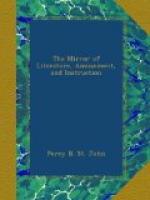Of Mr. Hope’s literary acquirements and his patronage of the liberal arts we have already spoken. It is, however, grateful to be enabled to refer to special acts of such patronage. It should not, therefore, be forgotten, that to the liberality of Mr. Hope, Thorwalsden, the celebrated Danish sculptor, is chiefly indebted for a fostering introduction to the world: we have seen at the liberal patron’s seat, Deepdene, a stupendous boar of spotless marble, for which the sculptor received a commission of one thousand guineas. Mr. Hope, too, was one of the earliest of the patrons of Mr. George Dawe, R.A. In a memoir of this fortunate and distinguished painter we find that “Andromache soliciting the Life of her Son,” from a scene in the French play entitled “Andromache,” was purchased by Mr. Hope, “who, in the most liberal manner, marked his approbation of Dawe’s talents by favouring him with several commissions for family portraits, especially a half-length of Mrs. Hope, with two of her children, and two whole-lengths of the lady singly.” To the useful as well as elegant arts Mr. Hope’s encouragement was extended; and for the last ten years he has filled the office of one of the Vice-presidents of the Society of Arts and Sciences in the Adelphi.
Mr. Hope usually passed “the season” at his superb mansion in Duchess-street, Portland-place, where he had assembled a valuable collection of works of art, altogether unrivalled, and comprising paintings, antique statues, busts, vases, and other relics of antiquity, arranged in apartments, the furniture and decorations of which were in general designed after classic models, by the ingenious possessor himself. Among the sculpture is the exquisite Venus rising from the Bath, by Canova. The whole of these valuables were open to the public, under certain restrictions, during “the season.” Mr. Hope likewise possessed one of the most delightful estates in the county of Surrey—viz. the Deepdene, near Dorking, to which he annexed Chart Park, purchased from the devisees of the late Sir Charles Talbot, Bart. On the last-mentioned estate is a spacious mausoleum, erected by Mr. Hope about thirteen years since, and capable of containing upwards of twenty bodies. Two of his sons, who died in their youth, are buried here.
In the retirement of the Deepdene, Mr. Hope passed much time in embellishing the mansion, and improving the gardens, grounds, &c. “Here,” observes the author of the Promenade round Dorking, “I was much gratified with landscape gardening, the quiet of echoing dells, and the refreshing coolness of caverns—all which combined to render this spot a kind of fairy region. Flower-gardens laid out in parterres, with much taste, here mingle trim neatness with rude uncultivated nature, in walks winding through plantations and woods, with ruined grottoes and hermitages, well adapted, by their solitary situations, for study and reverie.” Adjoining the mansion, Mr. Hope likewise constructed a classical sculpture gallery, which he enriched with several antiques from his town residence. Notwithstanding all these additions, we are bound to confess, that, compared with the beauty of the situation, they were but unsuccessful efforts of art to embellish bountiful Nature.




